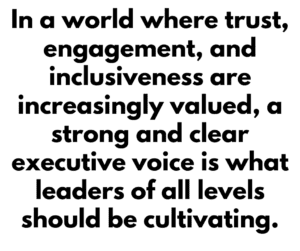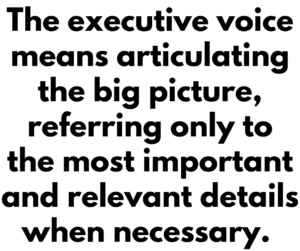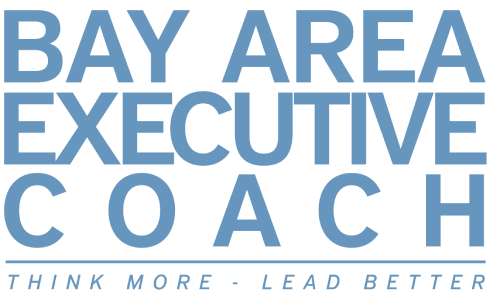In prior blog posts we’ve discussed in some detail the elements of “Executive Presence:” what it is and how it plays an important role in being an effective executive.
Now we’ll focus on one important aspect of Executive Presence referred to as “Executive Voice.” Its underlying principle is simple: how you say something can impact your audience as much, if not more, than what you say.
In a world where trust, engagement, and inclusiveness are increasingly valued, a strong and clear executive voice is what leaders of all levels should be cultivating. Good leaders and executives not only know what to say, but, using their executive voice, they know how to say it, in ways matched to the time, place, situation, and listeners.
What Is Executive Voice?
According to leadership expert Rebecca Shambaugh, executive voice is the “ability, through speech, tone of voice, and mannerisms, to establish credibility, inspire others, and influence stakeholders and other individuals within and outside your enterprise. 
It’s about inspiring and engaging people, creating a level of trust, setting the right tone for an organization and providing strategy. We all have audiences; we need to ask ourselves, ‘How can I best get on their channel? How can I best resonate with them, inspire, and influence something important?’”
Shambaugh concludes that leaders who want to rise to the top of their organization or field must embody a strategic executive voice that’s trusted, authoritative, and inspiring.
Tips for Developing Your Executive Voice
While your personal leadership style can and should be unique to you, there are proven strategies for finding a strong executive voice. Here are some tips for developing yours.
Be concise and clear.
Leaders with strong executive voices stay on target. They avoid jargon, don’t ramble, and speak plainly. A leader who addresses people thoughtfully and concisely not only imparts their strategies and ideas, but their wisdom as well.
Emphasize strategy over details.
The executive voice means articulating the big picture, referring only to the most important and relevant details when necessary. Think about it. Does the president, in the inaugural address, launch into a detailed and technical discussion on fiscal policies for balancing the national budget? No, the president talks about grand strategies for dealing with matters of pressing national concern. Facts, figures, and tech talk is best left for detailed reports or other occasions. The executive voice speaks best about the big picture.
Focus on solutions.
There’s a reason leaders are paid handsomely—they’re expected to originate bold and actionable solutions that others haven’t or aren’t able to see. Rather than bemoan problem after problem, a leader with a strong executive voice should bring innovative solutions that demonstrate sound strategic thought. 
Know your audience.
To find the best executive voice, first know your audience. Staying stubbornly “to script,” no matter what the audience needs or the context of the gathering, can silence the executive voice and lead to a disinterested and disengaged audience.
Your number one concern should be: who am I speaking to? What is it that’s important to them? What are their top concerns? What do they want to learn? What are the goals of the meeting? How can I bring value to the people assembled here?
Tailor your tone and your message to the people in front of you and you’ll be speaking with your executive voice.
Align your verbal and non-verbal communication.
Research tells us body language comprises 60 to 70 percent of communication. Therefore, your tone of voice, eye contact with the audience, facial expressions, posture, and the sincerity of your smile, are all important to your perceived executive voice. Be sure your non-verbal attributes run parallel with your verbal message.
Be prepared.
When it comes to projecting confidence, nothing beats preparation. Before meetings, presentations, briefings, or any face-to-face communications, take time to consider the needs of the people you’re meeting with, the information they’ll be looking for, and what your role will be. Come up with a few strategic questions too. Quality preparation will go a long way to helping you bring your authoritative, solutions-focused executive voice to every interaction.
Practice self-awareness to keep your cool.
When you have a deeper awareness of your hot buttons and knowledge gaps, you’re
less likely to enter dangerous territory in a difficult meeting where your emotions can get the better of you. Remember, the executive voice is not the voice of someone screaming out of control. It’s the credible voice of a leader who keeps their cool under pressure and understands how they’re coming across to others.
Be authentic.
Don’t try to sound like someone you’re not. Authenticity is critical to developing an executive voice. While it’s helpful to note the way others display leadership qualities, it’s important to develop your own style. Executive voice is as personal as it is powerful.
3 ways to Learn Executive Voice
 If some or all of these tips seem a bit daunting, remember that there are very few people born with an executive voice. The vast majority of us have to work at it and cultivate it over time. Here are three suggestions to accelerate that process:
If some or all of these tips seem a bit daunting, remember that there are very few people born with an executive voice. The vast majority of us have to work at it and cultivate it over time. Here are three suggestions to accelerate that process:
- Become an astute observer. Watch and listen to people who have a strong executive voice. Note how they hold themselves and what they’re doing to inspire and engage others. Ask yourself: “Why do people listen to them?“ and try to model some aspects of their style.
- Get feedback. Ask trusted people in your network for constructive, detailed feedback on your speaking style. Carefully consider everything they tell you, both the good and the not so good. Ask them: “What specific things or behaviors can I hone in on to help me be perceived as a strong leader by my audience?”
- Invest in a coach. A good executive coach can help you develop your executive voice a lot quicker than if you had to go it alone. Working with your coach, you’ll be able to target and implement the key elements for putting an executive voice into your key day-to-day interactions.
Finding your executive presence, and your executive voice, is just one of the areas where we’ve helped ambitious executives achieve greater success. Contact us today to schedule a conversation to talk about how we can help you.
Featured photo sourced from Pexels which can be found here and secondary photo also sourced from Pexels can be found here.










